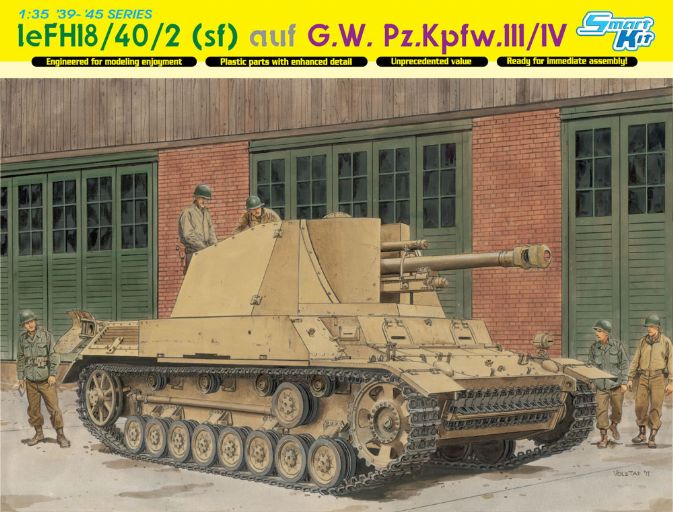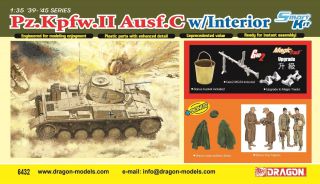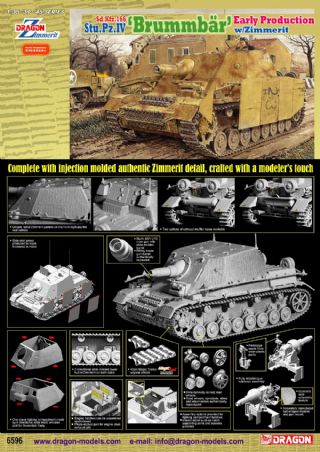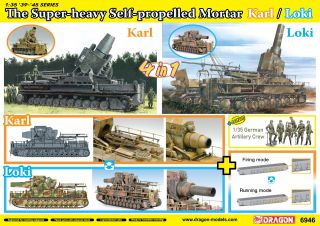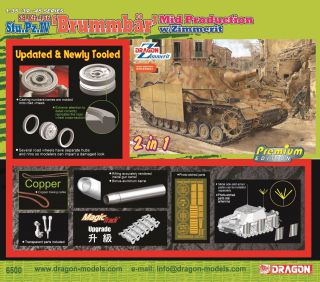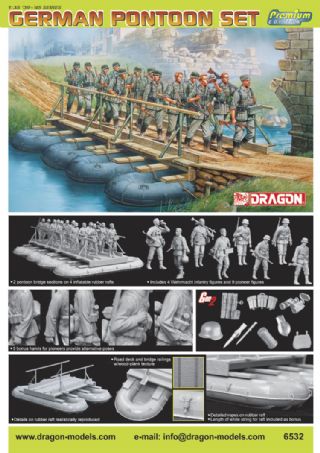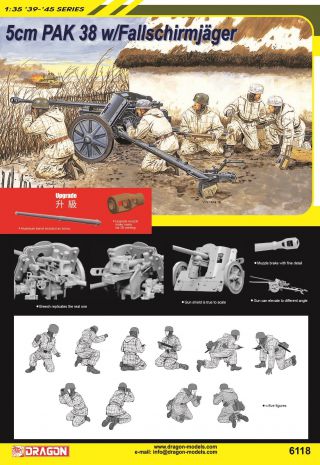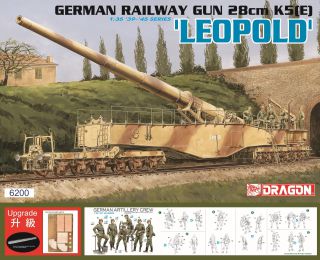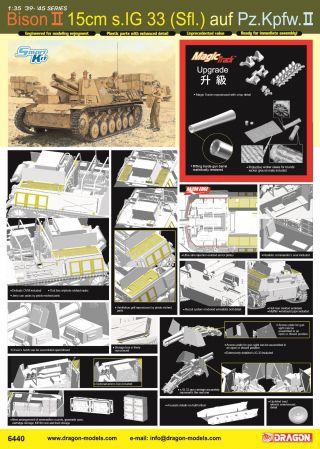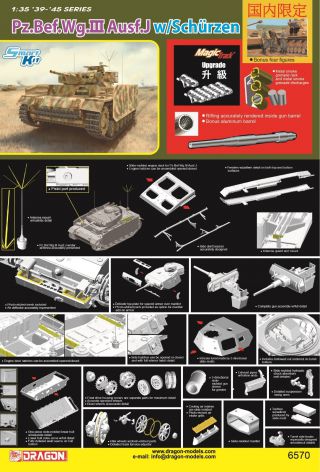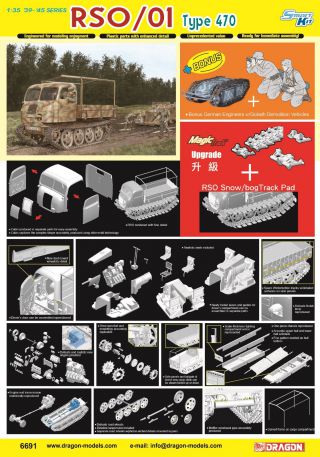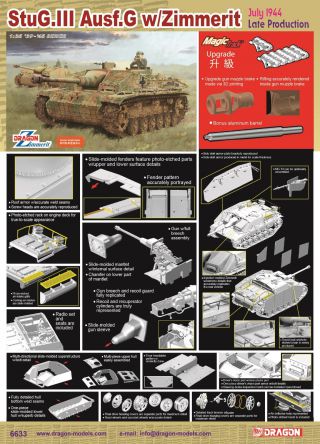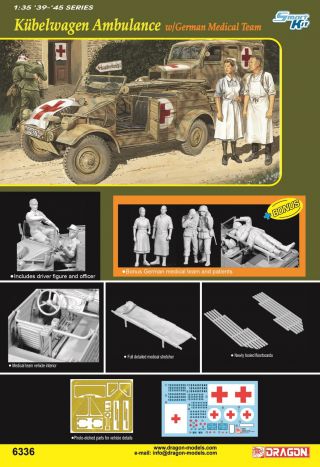HOME → Dragon Plastic Model Kits → 1/35 WWII Military → 6710
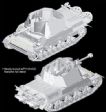

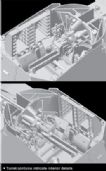
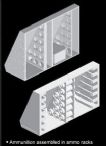


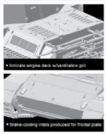















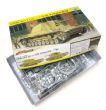
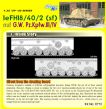
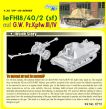
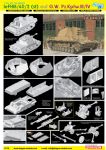
NEW TOOLING!!!
The first plastic injection model kit of this vehicle on market
Barcode: 0 89195 86710 0
Packaging: 20 Pieces per carton
Box Size: 9.6" x 15" x 3.1"
Features:
- Newly tooled leFH18/40/2 features full detail
- Newly tooled gun platform authentically produced
- Newly produced turret made by slide mold
- Delicate upper hull and fully detailed on hull bottom
- One-piece slide-molded lower hull w/exquisite detail
- Turret contains intricate interior details
- Ammunition assembled in ammo racks
- Armored shield mounted on turret
- Stowage locker included in turret
- Delicated gun sight reproduced
- Realistic gun has full detail
- Slide-molded hollow gun barrel w/finely detailed muzzle brake
- Gun can be separately assembled in either travel or combat version
- Gun trail stowed on hull rear
- Gun wheels included
- Intricate engine deck w/ventilation grill
- Brake-cooling inlets produced for frontal plate
- Magic Tracks reproduced
Germany designed a number of different self-propelled howitzers during WWII, but not all of them reached production. One of the more interesting types was the le.FH.18/40/2 auf.Pz.III/IV Sfl. With a name as convoluted as this, unsurprisingly it isn’t widely known! However, Dragon is giving this weapon carrier an enormous popularity boost by being the first manufacturer to create a 1/35 scale plastic kit of the weapon system! Basically the 25-ton vehicle mounted a 10.5cm le.FH.18/40/2 infantry gun in a fighting compartment, although it also carried gun trails and wheels on the rear of the hull so that the howitzer could be removed and used as a towed howitzer too.
Alkett / Rheinmetall-Borsig completed a prototype in March 1944 in direct competition to Krupp’s Heuschrecke 10. It was eventually decided that it would be based on a Geschutzwagen IV (Hummel) chassis, and it was designed to carry 80 ammo rounds and operate with a five-man crew. Production was scheduled to commence in February 1945 but no vehicles ever eventuated.
This was a unique design, and Dragon has given it very special treatment. The only parts in common with current kits are the road wheels, Magic Tracks and some OVM items – all other parts are brand new! Dragon is most certainly in the vanguard by being the first company to offer the le.FH.18/40/2 auf.Pz.III/IV Sfl. as a plastic kit. The le.FH.18 howitzer installed in the open-topped fighting compartment is a brand new creation. If they wish, modelers have the choice of assembling this infantry gun as a towed howitzer with its wheels and trails attached. The fighting compartment is full of detail – the gun mount, ammo storage racks and stowage bins are all there. The lower hull is made as one piece by slide mold. This is a stunning Smart Kit of a novel vehicle, and its appearance and unusual function are bound to draw admiration and invite curious questions from viewers!
Reviews
Kit, Cyberhobby 6710, le.FH18/40/2 (sf) auf G.W. Pz.Kpfw.III/IV
CYBERHOBBY
6710, le.FH18/40/2 (sf) auf G.W. Pz.Kpfw.III/IV Smart Kit. 1/35th-scale styrene/multimedia construction kit. Contains 763 styrene parts (including three clear), one etched brass fret, two bags of magic tracks, one water-slide decal/markings scheme with a variation and eight pages of instructions in 27 steps.
Introduction.
For reasons that today would pass understanding, during the Second World War, Germany had difficulties in conceptualizing and producing a viable self-propelled 10.5cm light field howitzer. Having settled on an overly complex design that included a facility to completely dismount the main gun for use on the ground, two models actually saw prototype construction. One came from Krupp (the subject of an earlier DML kit) while the other, the subject of this release, came from Alkett. By December, 1944, the Alkett design was also consigned to the also-ran category, with only the prototype surviving to be captured by the Western Allies.
Combining parts from a number of kits, along with new parts for the vehicle as well as new parts for a 10.5cm l.FH18/40, Cyberhobby has just released the le.Pz.Haub. Alkett. Note that this is a normal release, not a white box limited edition.
Tracks.
These Magic Track individual links represent the so-called Einheitsketten (standardized track link) that were 40cm-wide, had smooth cleats and opened guide horns. They require no clean-up of mold sprue attachment pips and fit together using friction (but will not stay together with any handling). They will need to be glued together when their position has been determined. Each has two very subtle knock-out pin marks on their inner faces, which will need the modelers attention. The links are handed, so be sure to work from one bag at a time and check the instructions carefully in order to identify the proper links for each side.
Suspension System.
The drive sprockets are the later type as fitted to the StuG.III, without the hub cap. The idler wheel is the welded tube type seen on the Pz.Kpfw.IV, but fitted with a hub cap from the idler wheel seen on the Pz.Kpfw.III. The road-wheels show the manufacturers logo. The return rollers are of the all-steel type. The idler wheels have a separate axle that can be slightly adjusted; this will aid in getting the proper sit of the track links; dont fix the idlers to their mounts until satisfied that all is correct with the tracks. The bogie units are multi-part assemblies and are fully-detailed through the use of clever parts break-down and slide-mold technology.
Hull.
The slide-molded hull is detailed with various rivets and mounting flanges. The mounts for the return rollers and idler wheels are all separate, with two-part bump stops added. The belly plate has the mounts and covers for the suspension bogies molded in place as well as various access panels and drain plates, plus fine rivet detail. This is all made possible by the use of a slide mold. Uniquely, a spare pair of road-wheels was stowed on each side of the hull wall, along with part of the lifting apparatus used to remove the gun from the chassis. These are all provided.
Separate fuel filler lids are given for the port-side of the hull, while inner plates for the final drives, complete with tow hook eyes are fitted on either side. Separate final drive covers are them put in place. The rear plate features three-part tow eyes on each corner, of the type seen in that location on a Pz.Kpfw.III hull. In the center is a three-part trailer hitch typically seen on the Pz.Kpfw.IV, which can be used to haul the dismounted howitzer. Large C-shaped brackets are provided to enable multi-part stowage racks to be fitted, which in turn held the wheels for the dismounted howitzer. The bow plate has a spare track stowage rack. The glacis plate is new for this kit. It has excellent panel and rivet detail, and is fitted with separate lift hooks, armored covers for the brake air cooling vents and etched brass brackets of various types.
Superstructure.
The front of the superstructure is composed of a separate drivers compartment roof with separate hatch lids. The front plate is separate and features a pair of separate drivers visors with internal detail to include etched brass hinges. The drivers hatch lids are also separate and there are separate view-port flaps on each side wall. Various parts make up the outer superstructure side panels on both sides. The plates are rendered using Razor Edge technology; this means that they are extremely thin, for excellent scale fidelity, while being devoid of any knock-out pin marks.
The engine deck module is a multi-part assembly with separate hatch lids, each of which has etched brass baffles on the inner surfaces. Separate grills are fitted to each side of the module. A pair of shovels along with mounting brackets for the guns trails is fitted on the rear face. Small detail parts include styrene lift hooks, grab handles and various fittings.
Track-Guards and OVM.
Typically, the track-guards are completely detailed on both surfaces and are devoid of ejector pin marks. The port-side track-guard mounts a four-part Tarnscheinwerfer-Bosch head-lamp, which includes power conduit. There is also a jack block, a pair of S-hooks with a separate mounting bracket, and, finally, an axe. On the starboard side sits a multi-part jack and its mounting brackets, as well as a pair of wire cutters. Separate mud-flaps complete the front end of the track-guards.
Fighting Compartment and Turret.
The fighting compartment has had much attention paid to it. Four parts make up the front and rear bulkheads, along with the turret race. The separate turret ring base is fitted with large support brackets and etched brass parts which are perforated; these would appear to be part of the ammunition stowage system. Beneath that, the large support brackets are connect to the circular turret floor plate.
The multi-part turret consists of two large parts which each contain the side wall and segents of the front and rear walls. Separate rear hatch lids can be fitted opened or closed and there are separate parts for the front end and the turrets base. Internally, there are large, multi-part stowage lockers on each side of the rear, as well as smaller stowage boxes; the larger lockers can be shown opened or closed. On each side are fitted large, multi-part ammunition racks, with what appears to be some stowed propellant cases molded in place. Separate hinges, latches, plates and gussets finish the area. Six 10.5cm projectiles are given, but their location is not shown, nor are they shown being used in the instructions. They are on the new sprue for the l.FH18/40 and so are probably designed for use as diorama accessories in the dismounted firing mode.
Gun and Mount.
The 10.5cm l.FH18/40 is based on a new set of parts, the carriage and trails of a standard 7.5cm PaK40, and wheels from the 15cm s.IG33, all as issued previously by DML. The slide-molded styrene gun tube is fitted with a nine-part breech block, which can be shown opened or closed. The over-sized flared muzzle brake is made up of three more parts. The recoil cylinder up top is separate as is its support yoke. The six part recoil sled is based on a slide-molded two-part core, which eliminates any seam running down the center, through the rivet pattern. The next items are the trunnions and elevation gear quadrant. The left side of the cradle has a recoil guard, five-part gun-sight (including clear parts); this assembly includes the direct and indirect sights. A multi-part assembly represents the traverse and elevation hand-wheels, as well as their linkages. The right side has another traverse hand-wheel and linkages, as well as a multi-part elevation piston. A multi-part base with some other detail parts completes this part of the gun.
The main splinter shield peculiar to this version of the l.FH18 is well-molded, thin and devoid of ejector pin marks. Internally it is fitted with various equipment stowage tubes and several struts which attach it to the gun and cradle. Externally, there is more in the way of stowage tubes, as well as a pick-axe. A pair of tiny hooks completes this part of the assembly. The shield is also fitted with wings on either side that fill-in the area between the splinter shield and the turret side walls. These are quite thinly-rendered and are embellished with multi-part etched brass hinges and mounting brackets, as well as more styrene mounting struts.
The axle units as seen on the PaK40 are next to be fitted. This assembly consists of some dozens of parts that make up hand-brakes, brake master cylinders, axles, brake hubs, and torsion bars. The wheel height can be adjusted. All of this is then mounted on to a 15-part assembly that connects the complete dismountable gun to the turret base. The last item unique to this AFV is what appears to be a screw jack, used to raise the gun out of the turret for fitting to the field carriage. It also appears to act as a travel lock for the gun cradle. It is composed of five parts.
The carriage can be configured in travel or firing mode depending on how parts are placed. In most cases this simply means moving a part on its appropriate hinge (trails, towing lunette and cradle lock) but the multi-part lower shield section must be fixed in either the raised (travel mode) or lowered (firing mode) position. It is not clear what is done with the lower shield sections when the howitzer is mounted inside the turret, but in that mode they cannot be fitted. The wheels are all-styrene slide-molded affairs, first seen on DMLs 15cm s.IG33 kit. They represent the cast star-pattern and because they are slide-molded, the tread detail is molded in place. However, the tire treads do not precisely match photos, which show that the center portion is noticeably wider than the two outer portions. The trails are fairly well-done, but they lack the prominent weld seam which ran along their entire length, as well as some finer details.
Molding, Fit and Engineering.
There are no sink marks or knock-out pin marks visible except where noted, and they are easily dealt with; mold seams are discrete and easily cleaned. Since I am passing this kit along to another modeler, I have not conducted a fit check of any of the new parts. However, past experience with the PaK40 carriage and the Pz.Kpfw.IV suspension system leads me to say that at least in those areas, there should be no surprises.
Accuracy.
The main components match well with Mr. Doyles scale profile in the cited Panzer Tracts book. I have mentioned a few items that are not as accurate as they should be, above. Very few photos are available to me regarding this vehicle, so I cannot comment any further on accuracy issues.
Instructions.
The instruction sheet consists of line drawings. The instructions are comparatively dense and can be confusing if care is not exercised. Colors are, as usual, coded to match Gunze and Testors paints.
Decals and Markings Information.
The water-slide decals are from Cartograf and are crisp, with well-saturated colors; carrier film is thin and cropped close to their edges. A total of two vehicles can be marked, although there was only one of these machines built. The markings show it before and after capture by the Allies, with the latter consisting of dark green patches of paint festooned with white shipping data; the type-face is not legible.
Conclusion.
Not a Paper Panzer, this AFV was actually built in prototype form and apparently still survives in the UK. It looks the part and is well-molded. It has loads of extra parts for the spares bin and includes a new-tool 10.5cm l.FH18/40, which I am quite sure will be released solo at some future date. Fans of all things German will want this one (especially those that like unusual prototypes), while fans of SP artillery in general may also like this kit for its oddness.
- Frank V. De Sisto
DR6710: 1/35 le.FH18/40/2(sf) auf G.W. Pz.Kpfw. III/IV
1/35 injection plastic kit with PE and decals
In 1944, Alkett tested a design for a self-propelled gun which mounted the 10.5cm Le FH field gun on a lengthen Panzer IV/III chassis. The distinguishing features of this design were that the turret could rotate 360 degrees, and that the gun could be field mounted and used as a standard towed field howitzer. To achieve this, the Geschuetzwagen III/IV chassis, which was derived from the Hummel's, also carried the field gun's wheels and trails. Trials found it took 15 to 20 minutes to dismount the gun. The entire AFV weighed 25 tones which was more than twice that of the Wespe, which was armed with a similar 10.5 cm howitzer. The sole prototype is currently on display at the Duxford military museum in England.
Overview
This new release depicts the trial vehicle as it was demonstrated to the army in May 1944 after incorporating initial feedback from the army. This kit contains considerable new tooling including parts for the lower hull, engine deck, jib crane, superstructure, gun and fighting compartment. The suspension and tracks are from the Smart Kit Panzer III/IV range and the gun's field carriage shares parts with related PaK and sIG.
The gatefold instructions have 27 steps of line drawings, which are clearly
drawn and keep each task as a distinct step (i.e. no step is overly busy) so
that you can build the kit as intended. If you plan to model the kit with the
turret dismounted, you will need to plan your project accordingly.
Howitzer and Fighting Compartment
The 10.5cm le FH 18/40 field howitzer was mounted in an open top fighting compartment/turret which was fixed to a turret race that was mounted low in the hull on a turntable. The parts for this turret and fighting compartment are all new tooling.
The turret’s side armor is slide molded and based on two large angled pieces
which each depict three plates on the real AFV. This ensures that the finished
kit will have nicely aligned appearance.. These parts are free on injection
sink marks and have sharp detail for hinges etc on both sides. The smaller support
and end plates are made from PE.. The rear doors are separate parts and other
parts provide the ammunition racks, lockers, handles and other fittings. The
internal detail compares favourably to photos and extends down to the turntable
to provide a comprehensive and accurate fighting compartment. The turret will
rotate 360 degrees when fitted to the hull.
The le FH 18/40 is also new tooling and had longer range than the le FH 18/6
which was fitted to other AFVs (eg. Heuschrecke). This gun is detailed with
the breech, sights (clear plastic), hand wheel, gunner’s seat, recuperator cylinders,
and recoil guard. The barrel tube is a single piece injection plastic with a
separate outer face for the muzzle break. The gun has a specially designed curved
gun shield which was shaped to fit inside the turret. This shield is built using
two multi angled slide molded parts, which fit together far better than traditional
tooling would. The gun is mounted onto the centre of the carriage which includes
the hubs for the wheels. The breech has a travel lock which was attached to
the turntable floor and is rather complex compared to most tank travel locks.
Hull and Rear Stowage
The lower hull is based on a slide-molded one piece tub which is new to this kit and features detail on the side walls and belly including weld beams and screw heads. The fairings are integrated on this hull, while the mounts for the return rollers and rear plate are separate. Separate parts are also used for the beam for a jib crane fitted along the hull sides, and the spare wheels which were also mounted on the hull sides.
The front of the hull is similar to the late production Hummel, and has separate
parts for the vision flaps, driver and radio operator hatches etc and uses PE
for the tow cable stays and option detail on the inside of the flaps.
The side fenders have the anti-skid pattern on the upper surface and underside.
The holes for the tools are predrilled and there are separate front and rear
fender flaps. The tools (clamps/brackets cast on), jack (six parts) and other
hull fittings are from related Panzer IV series kits. Spare tracks are fitted
to the front of the hull.
The hull rear is quite interesting and distinctive. Two large metal arms support the wheels for the howitzer’s field carriage. A pair of large protruding brackets with fasteners supports the trails for the field carriage. This AFV also had a unique engine deck, which is new tooling and has separate parts for the hatches (can be left open) and the louvered vents on the sides. PE is used for the baffles underneath the hatches.
Tracks
The pre-cut injection plastic Magic Tracks have open guide horns and are "handed" in that separate left and right side tracks are provided with the track pin facing out accordingly. Each set has its own bag and shade of gray. The outer faces have the plain profile (i.e. no chevrons). The links snap together for quick assembly.
The road wheels and bogies are from recent Panzer IV Smart Kits and have the
tyre and rim as one piece with separate hub-caps, while the bogies mountings
are built from four parts.
Decals
The instruction sheet suggests a solid dark yellow paint scheme as per the box art with the option of applying decals to depict a grey patch with white writing. This option matches photos from British archives. The decals correctly pick up photos which show that when captured that the grey paint on the right side extended lower than on the left.. The decal sheet also has three optional Balkan Crosses with solid black centers and white outline.
Recommendation
Dragon’s le.FH18/40/2(sf) auf G.W. Pz.Kpfw. III/IV has plenty of appeal. The complex open top design gives the kit a distinctive look, while offering the modeler something new and different. The crisp tooling, Magic Tracks and photo-etch all add to the appeal and ensure that it is a comprehensive out of the box model. Definitely recommended.
- Neville Lord
leFH18/40/2(sf) auf G.W.Pz.Kpfw.III/IV
Manufacturer: Cyber-Hobby
Scale: 1/35
Material: Styrene & photo-etch
Serial Number: 6710
Price: Unknown
Introduction
The vehicle this model represents was apparently similar in conception to the Heuschrecke IVb or 'Grasshopper' as it came to be known (at least by modern modellers!). The leFH18/40 was the main German field gun at Divisional level, so to combine this with the manoeuvrability of a self-tracked vehicle, and yet be able to remove said gun and mount on its carriage was an appealing idea. At least they got the first part right, and eventually they'd arrive at a proper SPG!
I can't find out much about this vehicle, but at least we do know that it actually existed. In fact I found two WWII photographs of one....then I discovered about 93 photographs of one that I had taken whilst crawling all over one at the Wheatcroft Collection. They'll make some very nice reference material too.
The Kit Contents
The kit is a very full box of plastic. Surprisingly little of it will end up in the spares box too. Although there are sprues from various other kits, this model does include some new ones to represent the fighting compartment, plus the mount for the gun etc., plus some other parts that you probably wouldn't expect, such as the carriage wheels from the s.IG.33 Infantry gun, explained later.
Back to where we should be for a moment, the parts are beautifully moulded as you would expect from Dragon/Cyber-Hobby in a brand new kit, and I gave up trying to get the parts back in the box once I originally photographed them, and just left them all over my bench until I came to write this. All the parts are shown below, with identical sprues each shown in a separate photograph...just to give you another feel of how much is in the box.
Construction begins with the installation of the various running gear components on to the new one-piece lower hull, which is itself detailed even on its lower surface. The suspension consists of paired wheels on a leaf-sprung bogie. These parts are from the Dragon Smart series Panzer IV kits, so most Axis modellers will be very familiar with their construction, and their finely moulded detail such as the manufacturer's logo's on the tyres of the roadwheels, even on the inner wheels, and the three absolutely minute welds holding the rims to the centres. The return roller arrangement on this one is asymmetric, being different on both sides. The tracks are of the individual Magic Track type, the ones for each side being supplied in a slightly different shade of grey to avoid confusion when assembling them.
Once the rear wall is in place, and various small details added to this, the superstructure can be assembled onto the hull itself. The front glacis has various details too, such as the ventilators for the brake housings, various brackets for tow ropes and tools, and also two armoured visors on the vertical superstructure wall behind it. These are detailed with photo-etched parts so that they can be modelled opened or closed,, and also have the armoured glass vision block holders behind each of them. Above these there is a short length of hull roof containing the two crew access hatches that allowed access to the very cramped driver's compartment.
At this stage the two fenders running the length of the vehicle are prepared together with the engine deck. The engine deck has separate grills and louvered panels at either side, which slant counter intuitively upwards, however, this is correct, as can be seen on the real vehicle. All these separately detailed components are then assembled to the lower hull, before construction begins on the upper superstructure and turret.
The upper superstructure is as you would expect, that is the walls are moulded extremely thinly, and considerable detail is provided for inside the fighting compartment, including full racks for ammunition and charges, and fully detailed gate doors for the rear of the fighting compartment, that can be modelled opened or closed. Although I've found few references on this vehicle, I do have many, many photographs taken of the inside of the fighting compartment on the real thing, and after pouring over them for some time, I can't find a bracket out of place. Not even the smallest detail, and the one I photographed is fairly complete and totally unrestored too.
Construction of the gun is next, and instructions are offered for mounting this on it's carriage if preferable, as opposed to in the vehicle. Although it's basically a leFH18, it's actually the leFH/18/40 which was mounted on a PaK40 carriage. Since Dragon have a large range of those guns, you can imagine where some of the parts originate. Construction begins with the gun slide, and assembly of barrel and breech on to it. The main barrel is supplied in plastic, although it is slide moulded so there aren't two halves to join, and no seam. Construction then moves onto the mount, which is incredibly detailed. The main shield is of course the PaK40 type, onto which two circular components are added. The real vehicle I photographed, was either missing these two circular components of the shield or never had them in the first place. Unfortunately it's almost impossible to know which?
The final part of the assembly is concerned around mounting the trail legs and wheels onto the rear wall of the vehicle. These are assembled in almost exactly the same way as they would be in the separate kit, and as mentioned, the option of displaying the gun mounted on the full carriage is offered on the instructions.
The marking schemes shown for the kit are for two schemes, one in overall dunkelgelb, and one with part of the paint wore through showing grey primer on both sides, with writing beneath. No idea what is says though. Both schemes are of unidentified vehicles.
Conclusion
It's an absolutely fascinating vehicle. I felt the same way about this as the Heuschrecke IVb when it was first released, and I just had to build that one too. Engineering looks damn near perfect, as does the moulding. I poured over the photographs I have of the real thing for ages, absolutely determined to find something they had missed. They haven't. I love it! Highly recommended.
- Vinnie Branigan
Kit Review: Dragon Models Limited 1/35 scale ‘39-‘45 Series Kit No. 6710; leFH18/40/2 (sf) auf G.W. Pzkw. III/IV; 1,054 parts (706 in grey styrene, 288 “Magic Track” single links, 57 etched brass, 3 clear styrene); pre-order price US$69.95 via Dragon USA Online
Advantages: probably the only kit of this vehicle to be produced in styrene; very well detailed and complete
Disadvantages: expensive kit for a one-off prototype
Rating: Highly Recommended
Recommendation: for German SP Artillery fans and “Panzer 46" fans
In most cases, for every vehicle which sees the light of day in production there are at least two competing prototypes in the running for a job. One wins and goes into production; quite often, this does not denote the best choice but the politically viable one.
This particular vehicle, Leichte PzH18/40/2 auf GW III/IV (sf), was the Rheinmetall-Borsig entry in the competition for the “Heuschreke 10" light self-propelled howitzer competition. The better known version, the 10.5 cm leFH18/1 L/28 auf Waffentraeger GW Ivb from Krupp, was its competition. Neither one was accepted for service.
Both vehicles featured a rotating turret with a 10.5 cm leFH 18 howitzer that could be dismounted for use in a fixed emplacement, leaving the carrier to function as an ammo transporter. But whereas the Krupp vehicle had a complete turret which dismounted onto a partially mobile framework, the Rheinmetall entry used the lightened 10.5 cm howitzer on a Pak 40 carriage which could be reinstalled on its wheeled carriage for separate use. Both vehicles carried racks for ammunition inside their structures.
However, by the time the vehicles were developed in 1943, things were turning for the Germans and it was no longer felt that the concept was viable.
While a number of kits of the Krupp “Heuschreke” have appeared over the years in 1/30 and 1/35 scale, this is the first kit of the “competitor” variant from Rheinmetall in injection molded styrene. DML has combined parts from its Panzer III/IV series kits and its 10.5 cm and 15 cm howitzer kits with a massive number of newly created parts (over 340) to create this model.
Other than the running gear, very little of the chassis comes from previous DML offerings. The hull is totally new and while the original was based on the GW III/IV chassis used for the late model Nashorn and Hummel the chassis pan has been completely modified for this kit. There are a number of new bits added to the running gear as well. It also appears DML either made a mistake or corrected one as there is a separate stern plate for the kit (blue G31) to mount the towing shackle and wheel storage mounts.
The engine deck is unique and shares no parts with previous kits. While a generic German jack is included (K sprue) it appears a more detailed one (G sprue) is used instead.
There is an open forward bulkhead inside the hull, but no interior detail in the driver’s/radio operator’s compartment. Most of the details - extensive ammo racks, as the vehicle was designed to carry 80 rounds of ammunition - go into the turret and its base. Propellant canisters are part of the racks, but the kit does come with six separate projectiles for the gun.
While the leFH 18 can be assembled as a complete weapon, the kit directions show it with the trails and wheels stowed (Step 26) and the howitzer in place in the turret. A folding travel lock at the rear of the turret basket is provided as well. The organic gun shield is fitted but two armored shields (J25 and J26) mount on it once installed in the turret. There is also a conversion base (parts L) for fitting the lower carriage minus the wheels and trails to the turret.
Technical consultants were Tony Greenland, Tom Cockle and Gary Edmundson.
There is only one finishing option with two alternatives for the kit: either sand overall or sand with an olive green patch and German stenciling (unreadable) on it. Both are listed as 1945, apparently dated from its capture by US troops (as shown on the box art by Ron Volstad).
Overall this is a nice but expensive kit of a one-off armored vehicle, but I know several modelers who have longed for it so it may find a good home.
- Cookie Sewell

